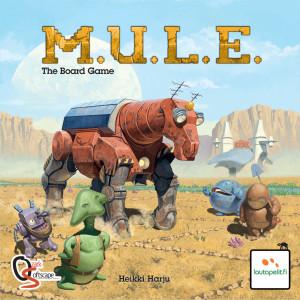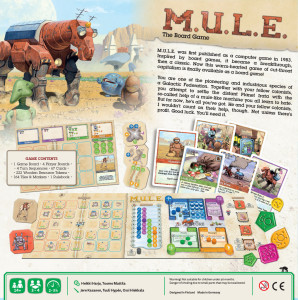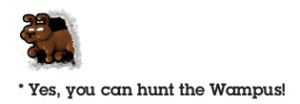In its August 17th press release, Ozark Softscape let a big, almost Wampus-sized cat out of the bag. A board game adaptation of the classic game will hit the stores this November 2015. The board game is created by Heikki Harju and published by Finnish board game company lautapelit.fi.
In this interview with World of M.U.L.E. (hereafter named “W.o.M.”), creator Heikki Harju (“H.H.”) tells the story of how the game came to be.
W.o.M.: The announcement of the M.U.L.E. board game was met with enthusiasm by the World of M.U.L.E. community. Thanks for sharing some of the game’s background story with us. First, please tell our readers a little bit about yourself.
H.H.: I am a lifelong M.U.L.E. fan from Helsinki, Finland. My day job is doing strategy and business development for high technology. Coming to think of it, M.U.L.E. is also about strategy and business development. I like playing games with strategy and business mechanics. When that’s not enough, I design my own board games. I also enjoy role-playing games a lot, and in my opinion M.U.L.E. also has a strong element of storytelling and identities that are built over a game. Immersion into the story and interaction with the other characters is part of its magic!
W.o.M.: What is your fondest memory of playing the original M.U.L.E. computer game? What’s your favourite species and colour to play with?
H.H.: I have so many fond memories associated with the game. The strongest memories are actually not about the game itself, but about the friendships built and strengthened when playing it. You know you can be Best Friends Forever with someone who can forgive you for letting them starve in a game of M.U.L.E. Then there are those feelings of competence you get when you manage to milk some cash by outsmarting The Store. I also remember when one of us accidentally caught the Wampus the first time. We were like: “what the heck is that?” At the time, I actually saw the picture of the cave as being part of the Wampus. It looked like some kind of a huge, kind blob. I usually played the Packer. I liked his positive attitude and the swing in his step. I usually chose the green colour because it was very clear on the screen against any background, and my friends graciously let me have it. Probably so that they could better keep their eyes on that opportunistic piece of smiling lettuce, i.e. me.
W.o.M.: How did you come up with the idea to create a board game based on a more than 30 years old computer game? When did you start the creative process, how long did it take?
H.H.: My first files date back from 2001, so it’s been almost 15 years in the making. When we started this project, we did it to play M.U.L.E. as a board game ourselves. To us (and many others), M.U.L.E. already felt like a great board game, but one that required an obsolete computer to play. M.U.L.E. wanted to become a real board game. In my opinion, M.U.L.E. should be played with your victims, (aka friends and fellow colonists), in the same room. I’m glad that other people have released have online versions for those who prefer to play that way or can no longer play face to face, but I actually think that board game with everyone assembled together is in many ways the best platform for this game. The only drawback is not being able to play the M.U.L.E. theme. But like one fan pointed out, I can easily do it myself! That said, I’d actually love to hear someone record an A Cappella version of the theme with three voices.
W.o.M.: Actually, there IS already an A Cappella version of the title theme, made by Swedish band Visa Röster! Not three voices, but at least A Cappella. Something to hum when starting the board game…
Wo.M.: What was the “work-split” with your co-creator Tuomo? Any anecdotes / early design drafts to share from the process?
H.H.: We started the project together, threw our ideas together and crafted the first prototypes together. We started by scavenging camels from Durch die Wüste and Tuomo crafted our first resource counters from ironing plastic jewelry beads. Over time, the project became increasingly my project, especially when it came to turning ideas into concrete prototypes. The fact that we live in different towns was part of it. That said, this game would never have happened without Tuomo. In the next few weeks, I’ll be publishing entries of a Designer’s Diary in boardgamegeek.com. Check out the game’s home page there for more information and updates. Give the game thumbs up and participate the conversation if you like what you see!
W.o.M.: The original computer game uses quite some “computational power” (for 1980’ies standards at least…) to support the human or human/computer gameplay – be it calculations of supply/demand, stock management in the town, economies of scale and the learning curve for production of goods. How did you tackle these aspects for the board game?
H.H.: We humans actually have very powerful computers in our heads. However, they are different from computers. Take numbers, for example. Using prices and quantities that vary between 0 and 255 is a very friendly design for an 8-bit computer. That’s not true for humans. We do best with numbers between 1 and 10. It’s not easy for most of us to count in our heads how much is 178 x 43, but counting 8 x 2 is quite easy. The same game mechanics can be built with these human-friendly numbers, it won’t change the big picture. In other ways, human brains are also superior to computers. For example, experienced players can tell from a glance who is currently winning the game. I guess we are conditioned to recognize who is stronger and who is weaker than us by nature. Teaching a computer to do this is very complicated and in any case usually results in a rigid model that flexible human minds can easily learn to beat. We like building our understanding of situations gradually and instill meaning into random events, creating a story in our heads as we go. For many reasons, I have not taken a “reverse engineering” design approach. Rather, I have tried to consider the original intent behind various mechanisms in M.U.L.E. (why they were put there, why they were built like that and how did computer medium affect that design choice). Then I tried to introduce a board game mechanism that achieves the same intent with human interaction and board game mechanics. Then I prototyped this, tried playing with it, get feedback. I’ve gone through dozens of design iterations until both the players and I liked it and it began “feeling” like M.U.L.E., or even better. Certainly more transparent and adaptable. After all, we are not bound by the limitations of a computer.
W.o.M.: The question of Wampus hunting has already been answered (yes, we can!). How about playing with less than four human players – how did you tackle the challenge of adding “artificial intelligence” (those clever Mechtrons!) into a board game?
H.H.: There are no “AI players” in M.U.L.E. The Board Game. The focus has been on getting the 3 to 4 player experience work with high player interaction. After all, if you want to play with AI, you can play with a computer. Adding a 5th player would be fairly easy and if we get enough demand to publish an expansion, that might very well be included. The game adjusts for 3 players with a few simple changes in set-up quantities. Two-player support would require more comprehensive changes or possibly even a different game. Again, maybe later.
W.o.M.: Judging from the board game cover design, you took extremely good care of capturing the original game’s design. How difficult did the designers (Jere, Tuuli, Ossi) find it to extrapolate from the crude early 1980’ies 8bit graphics to a modern design?
H.H.: It was always important for me that we are creating imagery for a story. The art should help people immerse with the game and put them in the mind of being rugged pioneers in a quirky planet. When we started creating the final art, at first someone proposed that we could use screenshot images from the 1983 computer game. I felt that was the easy way and while it might amuse us old-timers for a while, it would not build and enrich the story further and young people would just shake their heads. When we discussed with Jere about the art direction, we agreed that there should be a quality of frontier ruggedness in the player characters. We felt the M.U.L.E. itself to be an almost melancholy character, a character embodied for example by drones Huey, Dewey and Louie from Silent Running. We also decided to use a colour scheme that resembles the scheme of M.U.L.E. computer game, just with a bit softer tones. Ossi, our cover artist did much of the heavy lifting to begin the process, and he had to bear with our endless requests to change this or that based on our vague verbalizations. In the end, we were very happy with the outcome, though! Then Tuuli, who is a very skilled cartoonist, took over to create the art for game components. Using Ossi’s work as a springboard, her art took us off like a runaway M.U.L.E. Creating that spark of life and soul comes naturally to Tuuli (after just years and years of practice). I promise you’ll be amazed when you see her imagery in the cards.
W.o.M.: How did you manage the publishing process?
H.H.: There are many reasons why the process took so long: For the first years, I was just making this for our own use. There were years when I did nothing with it and it was just sitting in my drawer. Then, when I first thought about publishing it, the ownership of M.U.L.E. trademark was unclear to the public. I even once approached you, Christian, about it, many years ago, but back then even you were uncertain. Finally, finalization and publishing takes time, and unfortunately our first publisher candidate went bankrupt during the process. For a long time, publishing seemed impossible and no-one seemed to know who actually owned the brand. I absolutely wanted to respect the creators and did not want to come up with another design. So it was for years. This changed when Ozark Softscape was re-created. I just accidentally found them one day with a search engine. Later I saw they had endorsed Planet M.U.L.E.. Suddenly, licensing the brand was a real possibility. That opened doors to publishers. Our first publisher candidate Tuonela Productions took us to their booth in Spiel 2011 (thanks guys!) where we demoed the game to anyone who happened to find us. Again, the feedback was very encouraging and constructive. Many people just wanted to buy the game right away. Unfortunately, Tuonela went under. However, now we had met and talked with several publishers on both sides of the Atlantic who were interested. Eventually I decided to go with Lautapelit.fi: The ideal partner for us, since they were both located in my home town and had proven their ability to reach a global audience with Eclipse.
W.o.M.: You contacted me so many years ago that I probably forgot about it, as old as I am meanwhile! 😉 But now, the final question is – Atari or Commodore? 😉
H.H.: My gaming platform was C64, back in history. It’s still the best platform for playing the M.U.L.E. theme music via its unique SID sound chip.
W.o.M.: Thanks for your time, all the best and have a successful launch!
H.H.: Cheers to all and stay tuned!




